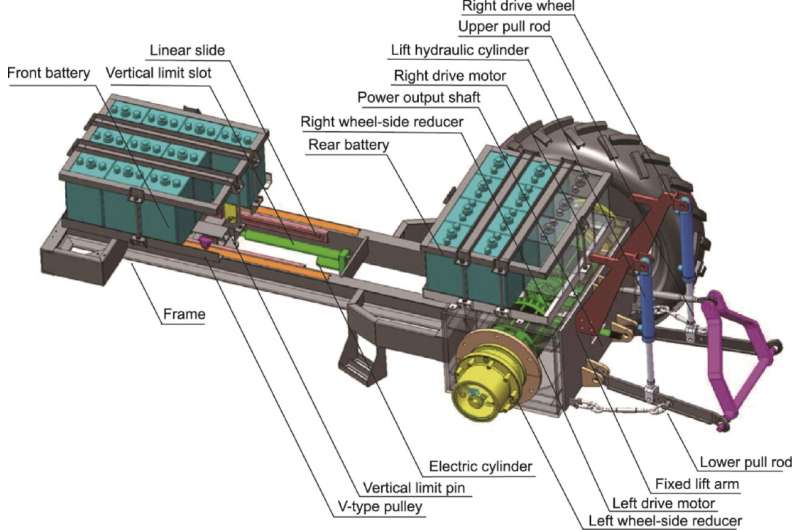This article has been reviewed according to Science X's editorial process and policies. Editors have highlighted the following attributes while ensuring the content's credibility:
fact-checked
proofread
Reducing operation emissions and improving work efficiency using a pure electric wheel drive tractor

Electric tractors are intended to be used in the field instead of traditional fuel tractors and can be used in greenhouse planting, indoor farming, mountainous operations, and other special operating scenarios. Unlike traditional fuel tractors, electric tractors have no exhaust emissions, rapid drive system response, flexible power output, or other advantages.
These scenarios require electric tractors to be able to adapt to complex drive and operating environments, putting higher requirements on the design of electric tractors and their control systems. Therefore, improving the operating efficiency of electric tractors and giving full play to their traction capacity have become urgent breakthrough issues.
Specifically, existing tractors suffer from reduced traction efficiency, low fuel efficiency, and high greenhouse gas emissions when plowing on complex field surfaces.
These issues are manifested as follows: high wheel slip due to the inability to achieve differential torque distribution between the left and right drive wheels, unreasonable front- and rear-axle load distribution due to the inability to continuously and intelligently regulate the fixed counterweight, and low tillage quality due to the inability of the electro-hydraulic suspension system to balance the agronomic requirements of the operation with the traction performance of the unit.
Therefore, in response to the problems of excessive greenhouse-gas and particulate emissions and the low traction efficiency of conventional diesel tractors in the field, a purely electric wheel-side drive tractor was studied, including an electric motor drive system, a battery ballast system, and an electro-hydraulic suspension system.
This paper develops a dynamics model of an electric tractor-plowing unit under complex soil conditions, leading to the proposal of an active control method for drive wheel torque and a joint control method for the traction force of the suspension system and the front- and rear-axle loads of a tractor.
Finally, the tractor is prototyped and assembled, and plowing tests are carried out. The plowing results show that the active torque-distribution control method proposed in this study reduces the tractor slip by 14.83% and increases the traction efficiency by 10.28% compared with the average torque-distribution mode.
Compared with the conventional traction control mode, the joint control method for traction and ballast proposed in this paper results in a 3.7% increase in traction efficiency, a 15.05% decrease in slip, and a 4.9% reduction in total drive motor energy consumption.
The paper titled "Reducing Operation Emissions and Improving Work Efficiency Using a Pure Electric Wheel Drive Tractor" was published in Engineering.
The main contributions of this work are as follows:
- A new overall configuration for an electric tractor, composed of a wheel-side motor independent drive system, a battery ballast system, and a direct-drive electro-hydraulic suspension system, is proposed to provide an intelligent carrier for the key system and the whole machine in order to realize high-efficiency control.
- To overcome the problems of longitudinal wheel slip, rearward shift of the center of gravity of the unit, and insufficient traction power of the whole tractor during field operation, a nine-degrees-of-freedom (9-DOFs) electric tractor dynamics model is constructed; moreover, an active control method for the driving wheel torque and a joint control method for the traction force and the front- and rear-axle loads are researched.
- This study will help to improve the operation quality and traction efficiency of electric tractors in complex soil conditions.
More information: Chang-Kai Wen et al, Reducing Operation Emissions and Improving Work Efficiency Using a Pure Electric Wheel Drive Tractor, Engineering (2024). DOI: 10.1016/j.eng.2024.01.026




















